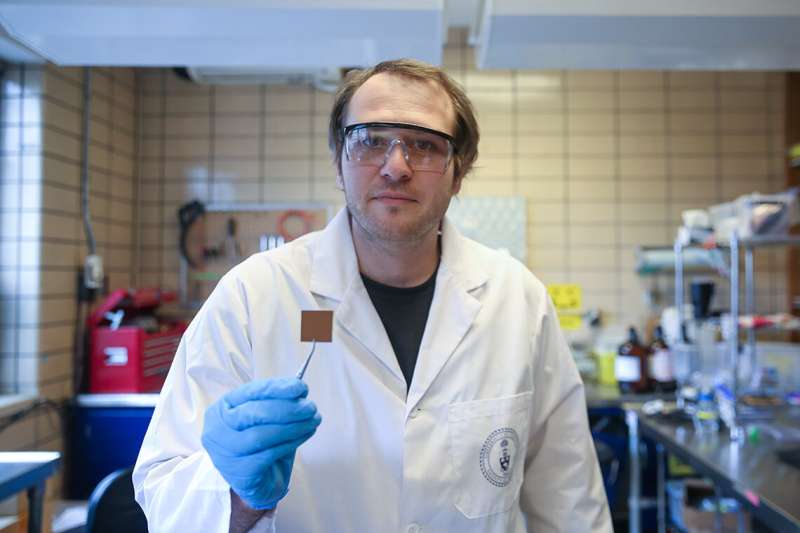
A new catalyst design created by researchers at the University of Toronto’s Faculty of Applied Science & Engineering could significantly improve the practicality of an electrochemical process that converts captured carbon dioxide into multi-carbon molecules—some of the key building blocks of the chemical industry.
“We need alternative routes to everyday products that do not require fossil fuel inputs,” says David Sinton, a professor of mechanical and industrial engineering and senior author on a new paper published in Nature Energy.
“With recent advances in carbon capture, there is an opportunity to use CO2 to replace core chemical feedstocks on which the modern world relies. By developing cost-effective ways to upgrade this carbon into products we already need, we can increase the economic incentive to capture, rather than emit, CO2.”
One way to upgrade carbon involves electrochemistry—electricity used to drive forward a desired chemical reaction. The conversion is carried out in devices known as electrolyzers, where electrons combine with the reactants at the surface of a solid catalyst.
The team has a proven track record of successfully developing innovative ways to improve the efficiency of electrochemical CO2 conversion.
In their latest published work, the researchers focused on a variant of the process known as “cascade CO2 reduction.” In this two-step process, CO2 is first dissolved in a liquid electrolyte and then passed through an electrolyzer, where it reacts with electrons to form carbon monoxide (CO).
The CO is then passed through a second electrolyzer where it is converted into two-carbon products such as ethanol, which is commonly used as fuel, and ethylene, which is a precursor to many types of plastics as well as other consumer goods.
It is at this second step where the team found inefficiencies they believed could be overcome. The challenges were related to selectivity, which is the ability to maximize production of the target molecules by reducing the formation of undesirable side products.
“One of the key issues is the poor selectivity under low reactant availability,” says post-doctoral researcher Adnan Ozden, one of four lead authors on the new paper.
“This, in turn, leads to a trade-off between the energy efficiency—meaning how efficiently we use the electrons we pump into the system—versus the carbon efficiency, which is a measure of how efficiently we use CO2 and CO.”
“There are ways to achieve high energy efficiency, and there are ways to achieve high carbon efficiency, but they are usually approached separately,” says former post-doctoral researcher Jun Li, another of the lead authors, who is now an associate professor at Shanghai Jiao Tong University. “Achieving both in a single-operation mode is the key.”
The team investigated the reasons for this trade-off and found that it originates from excessive accumulation of the positively charged ions, known as cations, on the catalyst surface, as well as the undesirable migration of the negatively charged ions, known as anions, away from the catalyst surface.
To overcome this challenge, they took inspiration from the design of supercapacitors, another electrochemical system where the transport of ions is critical. They added a porous material, known as a covalent organic framework, onto the surface of the catalyst, which enabled them to control the transport of cations and anions in the local reaction environment.
“With this modification, we obtained a highly porous, highly hydrophobic catalyst layer,” says Li.
“In this design, the covalent organic framework interacts with the cations to limit their diffusion to the active sites. The covalent organic framework also confines the locally produced anions due to its high hydrophobicity.”
Using the new catalyst design, the team built an electrolyzer that converts CO into two-carbon products with 95 percent carbon efficiency, while also keeping energy efficiency relatively high at 40 percent.
“When you look at what has been achieved so far in the field, the various approaches have tended to focus either on getting really high energy efficiency, or really high carbon efficiency,” says Ozden. “Our new design shows that it’s possible to break this trade-off.”
There is still more work to be done. For example, while the prototype device maintained its performance for more than 200 hours, it will need to last even longer if it’s to be used industrially. Still, the new strategy shows potential in terms of its ability to improve the value proposition of upgrading captured carbon.
“If this process is going to be adopted commercially, we need to be able to show that we can accomplish the conversion in a way that’s scalable and cost-effective enough to make economic sense,” says Sinton. “I think our approach demonstrates that this is a goal within reach.”
More information:
Adnan Ozden et al, Energy- and carbon-efficient CO2/CO electrolysis to multicarbon products via asymmetric ion migration–adsorption, Nature Energy (2023). DOI: 10.1038/s41560-022-01188-2
Citation:
Researchers capture carbon more effectively with new catalyst design (2023, January 23)
retrieved 23 January 2023
from https://techxplore.com/news/2023-01-capture-carbon-effectively-catalyst.html
This document is subject to copyright. Apart from any fair dealing for the purpose of private study or research, no
part may be reproduced without the written permission. The content is provided for information purposes only.
Stay connected with us on social media platform for instant update click here to join our Twitter, & Facebook
We are now on Telegram. Click here to join our channel (@TechiUpdate) and stay updated with the latest Technology headlines.
For all the latest Technology News Click Here
For the latest news and updates, follow us on Google News.
